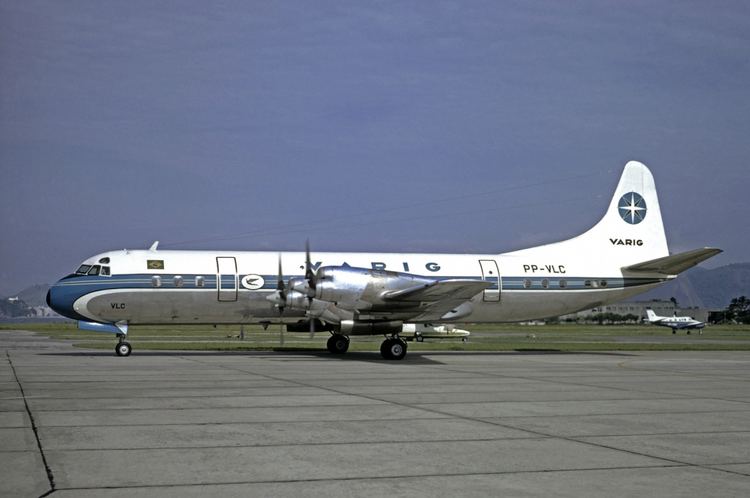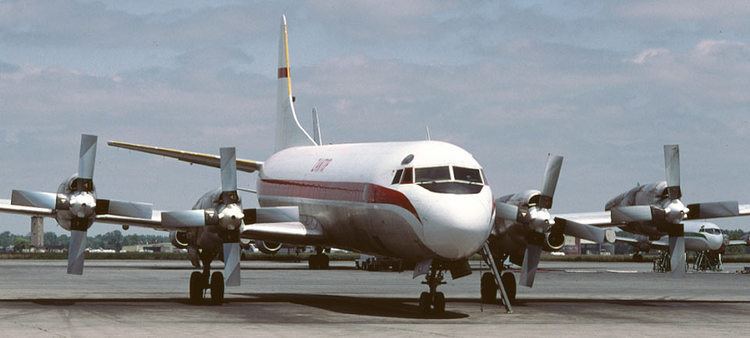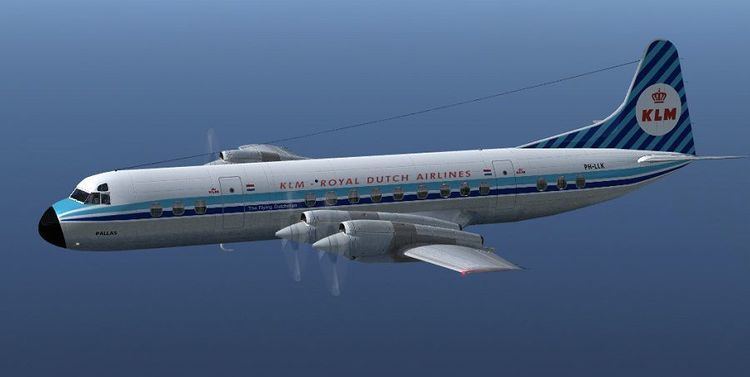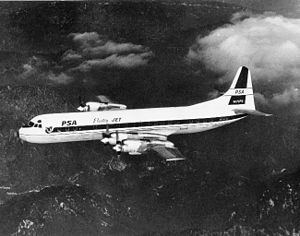Top speed 721 km/h Length 32 m Manufacturer Lockheed Corporation | Wingspan 30 m Engine type Allison T56 First flight 1957 | |
 | ||
Similar Lockheed L 1011 TriStar, Lockheed L 1049 Super Constellation, Lockheed C 130 Hercules | ||
Lockheed l 188 electra takeoff
The Lockheed L-188 Electra is an American turboprop airliner built by Lockheed. First flown in 1957, it was the first large turboprop airliner built in the United States. Initial sales were good, but after two fatal crashes that led to expensive modifications to fix a design defect, no more were ordered. With its unique high power-to-weight ratio, huge propellers and very short wings (resulting in the majority of the wingspan being enveloped in propwash), large Fowler flaps which significantly increased effective wing area when extended, and four-engined design, the airplane had airfield performance capabilities unmatched by many jet transport aircraft even today—particularly on short runways and high field elevations. Jet airliners soon supplanted turboprops for many purposes, and many Electras were modified as freighters. Some Electras are still being used in various roles into the 21st century. The air-frame was also used as the basis for the much more successful Lockheed P-3 Orion maritime patrol aircraft.
Contents
- Lockheed l 188 electra takeoff
- Development
- Design
- Civilian operations
- Military use
- Variants
- Current operators
- Military operators
- Orders
- Aircraft on display
- Accidents and incidents
- Specifications Model 188A
- References

Development

Lockheed had established a strong position in commercial airliner production with its piston-engine Constellation series. Further development brought turboprop engines to the Constellation airframe with the Lockheed L-1249 Super Constellation. In 1951, Lockheed was approached by Capital Airlines to develop a new turboprop airliner which was designated the YC-130, however there was no interest from any other carriers, so the design was dropped. Subsequently, Capital Airlines went on to order 60 British Vickers Viscounts. In 1954, as a result of American Airlines' interest in developing a twin engine aircraft, the idea resurfaced and the company offered a twin-engine design now designated the CL-303. This newer design was a high-wing type and would allow for 60 to 70 passengers. This design was also shelved for lack of interest from other carriers.

The following year, American Airlines revised its requirement to a four-engine design for 75 passengers with 2,000 miles (3,200 km) range. Lockheed proposed a new design, the CL-310 with a low wing and four Rolls-Royce Darts or Napier Elands. The CL-310 design met the American Airlines requirement, but failed to meet another interested carrier; Eastern Air Lines. Its requirements were for a longer range; a minimum cruising speed of 350 miles per hour (560 km/h); and increased seating capacity to the 85-to-90-passenger level. Lockheed redesigned the CL-310 to use the Allison 501-D13, a civilian version of the T56 developed for the Lockheed C-130 Hercules military transport. The airframe was stretched to allow for more seats and handle the increased performance. This design was launched as the Model 188 with an order for 35 by American Airlines on June 8, 1955. This was followed by Eastern Air Lines with an order for 40 on September 27, 1955. The first aircraft took 26 months to complete and by that time Lockheed had orders for 129. The prototype, a Model 188A, was completed and first flew on December 6, 1957, two months ahead of schedule. Lockheed was awarded a type certificate by the Civil Aeronautics Administration (CAA) on 22 August 1958. The first delivery – to Eastern Air Lines – was on October 8, 1958 but it did not enter service until January 12, 1959.
In 1957 the United States Navy issued a requirement for an advanced maritime patrol aircraft. Lockheed proposed a development of the Electra that was later placed into production as the P-3 Orion, which saw much greater success — the Orion has been in continual front-line service for more than 50 years.
Design
The Model 188 Electra is a low-wing cantilever monoplane powered by four wing-mounted Allison 501-D13 turboprops. It has a retractable tricycle landing gear and a conventional tail. It has a cockpit crew of three and can carry 66 to 80 passengers in a mixed-class arrangement, although 98 could be carried in a high-density layout. The first variant was the Model 188A, followed by the longer-range 188C with room for 1,000 US gallons (3,800 L) more fuel and maximum take-off weight 3,000 pounds (1,400 kg) higher.
Civilian operations
American Airlines was the launch customer. Eastern Air Lines, Braniff Airways and Northwest Airlines followed. The Electra suffered a troubled start. Passengers of early aircraft complained of noise in the cabin forward of the wings, caused by propeller resonance. Lockheed redesigned the engine nacelles, tilting the engines upwards three degrees. The changes were incorporated on the production line by mid-1959 or as modification kits for the aircraft already built, and resulted in improved performance and a better ride for passengers.
Three aircraft were lost in fatal accidents between February 1959 and March 1960. After the third crash the FAA limited the Electra's speed until the cause could be determined.
After an extensive investigation, two of the crashes (in September 1959 and March 1960) were found to be caused by an engine mount problem. The mounts were not strong enough to damp a phenomenon called "whirl mode flutter" (analogous to the precession of a child's top as it slows down) that affected the outboard engine nacelles. When the oscillation was transmitted to the wings and the flutter frequency decreased to a point where it was resonant with the outer wing panels (at the same frequency, or harmonically related ones), violent up-and-down oscillation increased until the wings would tear themselves off. The company implemented an expensive modification program (the Lockheed Electra Achievement Program or LEAP) in which the engine mounts and the wing structures supporting the mounts were strengthened, and some of the wing skins replaced with thicker material. All Electras were modified at Lockheed's expense at the factory, the modifications taking 20 days for each aircraft. The changes were incorporated in later aircraft as built. However, the damage had been done, and the public lost confidence in the type. This and the smaller jets that were being introduced eventually relegated Electras to the smallest airlines. Production ended in 1961 after 170 had been built. Losses to Lockheed have been estimated as high as $57 million, not counting an additional $55 million in lawsuits. They continued to carry passengers into the 1980s, but most Electras now in use are freighters.
Many airlines in the US flew Electras, but the only European airline to order the type from Lockheed was KLM which used twelve between September 1959 and January 1969 in Europe and east to Saigon and Kuala Lumpur.
In the South Pacific, Tasman Empire Airways Limited (TEAL) and its successor Air New Zealand flew the Electra on trans-Tasman flights. In Australia Trans Australia Airlines (TAA) and Ansett each operated three Electras on the trunk routes between the Australian mainland state capital cities, and later to Port Moresby, from 1959 until 1971. Ansett had its three Electras converted to freighters in 1970–71 and continued to fly them until 1984. Qantas also operated four Electras on its routes to Hong Kong and Japan; to New Caledonia; and to New Guinea (until the New Guinea route was handed to Ansett and TAA); then later across the Indian Ocean to South Africa, and across the Tasman in competition with TEAL after that airline became 100% New Zealand-owned. The divestiture of TEAL's 50%-Australian shareholding was itself prompted by the Electra order, as TEAL wanted jet aircraft, but was forced by the Australian government to order Electras to standardise with Qantas. Three Qantas Electras were retired in the mid-1960s and the fourth in 1971.
Some Electras were sold to South American airlines, where, contrary to what had happened in the U.S., the Electra had highly successful operations, such as those of Lloyd Aéreo Boliviano and Líneas Aéreas Paraguayas; in both cases, the Electra ensured the airlines' international operations before they started using jets. Most notably, Varig from Brazil operated the Electra on the extremely busy Rio de Janeiro-São Paulo shuttle service (the so-called Ponte Aérea - "Air Bridge," in Portuguese) flawlessly for many years and completing over half a million flights on the route before the type was replaced by Boeing 737-300 and Fokker 100 jets in 1992, and mostly sold to then Zaïre the following year. The Electra became so iconic on that route that its retirement caused a commotion in Brazil, with extensive press coverage and many special tributes.
During the mid-1970s, several secondhand Electras were bought by travel clubs, including Adventurers and Shillelaghs. Others were retired from passenger service into air cargo use, 40 being modified by a subsidiary of Lockheed from 1968 with one or two large doors in the left side of the fuselage and a reinforced cabin floor. Air California and Pacific Southwest Airlines were still operating Electras for passenger service during the late 1970s into smaller airports in the western United States.
Military use
In 1973, the Argentine Navy bought three Electras equipped with cargo doors. These were used during the "Dirty War" to toss political prisoners into the Rio de La Plata, in the infamous death flights. The Electras were also used for transport duties during the Falklands War in 1982.
In 1983, after the retirement of its last SP-2H Neptune, the Argentine Navy bought further civilian Electra airframes, modified several for maritime patrol, and widely used them until their replacement by P-3s in 1994. One of the Argentine Navy's Electras, known locally as L-188E Electron, is preserved at the Argentine Naval Aviation Museum (Museo de la Aviación Naval) at Bahía Blanca.
Variants
Current operators
As of November 2016, a total of 14 Electras remain in active service with three Canadian companies as follows:
Military operators
Orders
Aircraft on display
Accidents and incidents
Of the total of 170 Electras built, as of June 2011, 58 have been written off because of crashes and other accidents.
Specifications (Model 188A)
Data from Lockheed Aircraft since 1913
General characteristics
Performance
